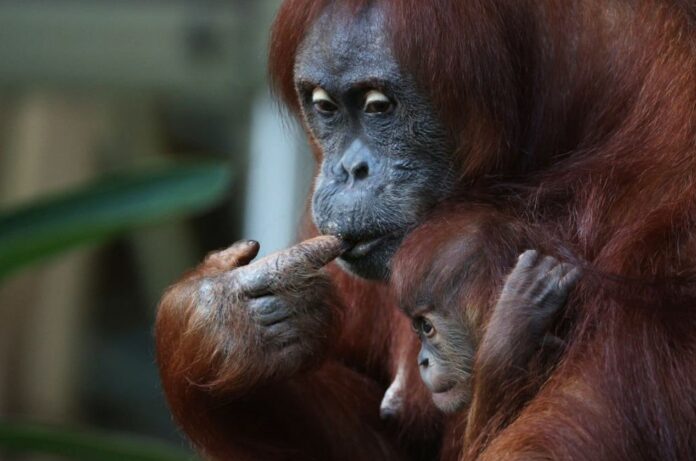Where did all the consonants, that compose all the world’s languages, originally come from?
According to new research from the University of Warwick, orangutans, the most tree-dwelling of the great apes, produce consonant-like calls more frequently and in a wider variety than their African ground-dwelling relatives (gorillas, bonobos, and chimpanzees).
Contrary to popular belief, African apes don’t have call repertoires that resemble human speech despite being closely related to us. A large and diverse inventory of consonant-like cries seems to have emerged from tree-dwelling apes like orangutans rather than ground-dwelling apes, suggesting that arboreal vs terrestrial lifestyles drove great apes to create divergent vocal repertoires. The findings implies that our evolutionary predecessors may have inhabited trees more often than previously believed.
Dr. Adriano Lameira, an Associate Professor of Psychology at the University of Warwick, studied the origins of human spoken language, which consists of voiced sounds in the form of vowels and voiceless sounds in the form of consonants.
For decades, researchers have examined non-human primates to learn more about how speech and language developed in our species. However, voiced vowel-like sounds make up the majority or all of the sounds in non-human primates’ calls.
“This raises questions about where all the consonants, that compose all the world’s languages, originally come from,” adds Dr Adriano Lameira.
“Existing theories of speech evolution have thus far, focused exclusively on the connection between primate laryngeal anatomy and human use of vowels.
“This doesn’t explain though, how voice-less, consonant-like sounds became a fundamental component of every language spoken around the globe.”
To understand the origins of human speech and the origins of consonant sounds in the human lineage, Dr. Lameira compared the use of consonant-like vocalizations in the vocalizations of three major great ape lineages that still exist today – orangutans, gorillas, bonobos, and chimpanzees.
Great ape call repertoires include both consonant-like and vowel-like cries, unlike those of other primates but like those of any spoken human language. But the way great apes use consonant sounds in nature is not always the same.
“Wild gorillas, chimpanzees and bonobos,” according to him, “don’t use a huge variety of consonant-like calls.
“Gorillas for example, have been found to use a particular consonant-like call, but this is only prevalent in some gorilla populations and not others. Some chimpanzee populations produce one or two consonant-like calls associated with a single behaviour, for example while they are grooming, but these same grooming calls are uncommon in other chimpanzee populations.
“Wild orangutans, however, use consonant-like calls universally and consistently across different populations and for multiple behaviours, much like humans do with speech. Their vocal repertoire is a rich display of smacking, clicks, kiss-sounds, splutters and raspberries.”
Professor Lameira has been watching orangutans in their natural habitat for the last 18 years. He says that the fact that they live in trees and eat leaves could help explain why their calls sound like words.
“All apes are accomplished extractive foragers. They have developed complex mechanisms to access protected or hidden foods like nuts or plant piths, which often requires either meticulous use of hands or tools. Apes such as gorillas and chimpanzees need the stability of the ground in order to successfully handle these foods and use tools, however orangutans are largely tree-dwelling, and access their food up in the canopy, where at least one of their limbs is constantly used to provide stability among the trees.
“It is because of this limitation, that orangutans have developed greater control over their lips, tongue and jaw and can use their mouths as a fifth hand to hold food and manoeuvre tools. Orangutans are known for peeling an orange with just their lips so their fine oral neuro-motoric control is far superior to that of African apes, and it has evolved to be an integral part of their biology,” adds Dr. Lameira.
This research suggests that living in trees may have been a precursor to the development of consonants and, by extension, the evolution of speech in our human ancestors.
Image Credit: Steve Russell/Toronto Star via Getty Images
